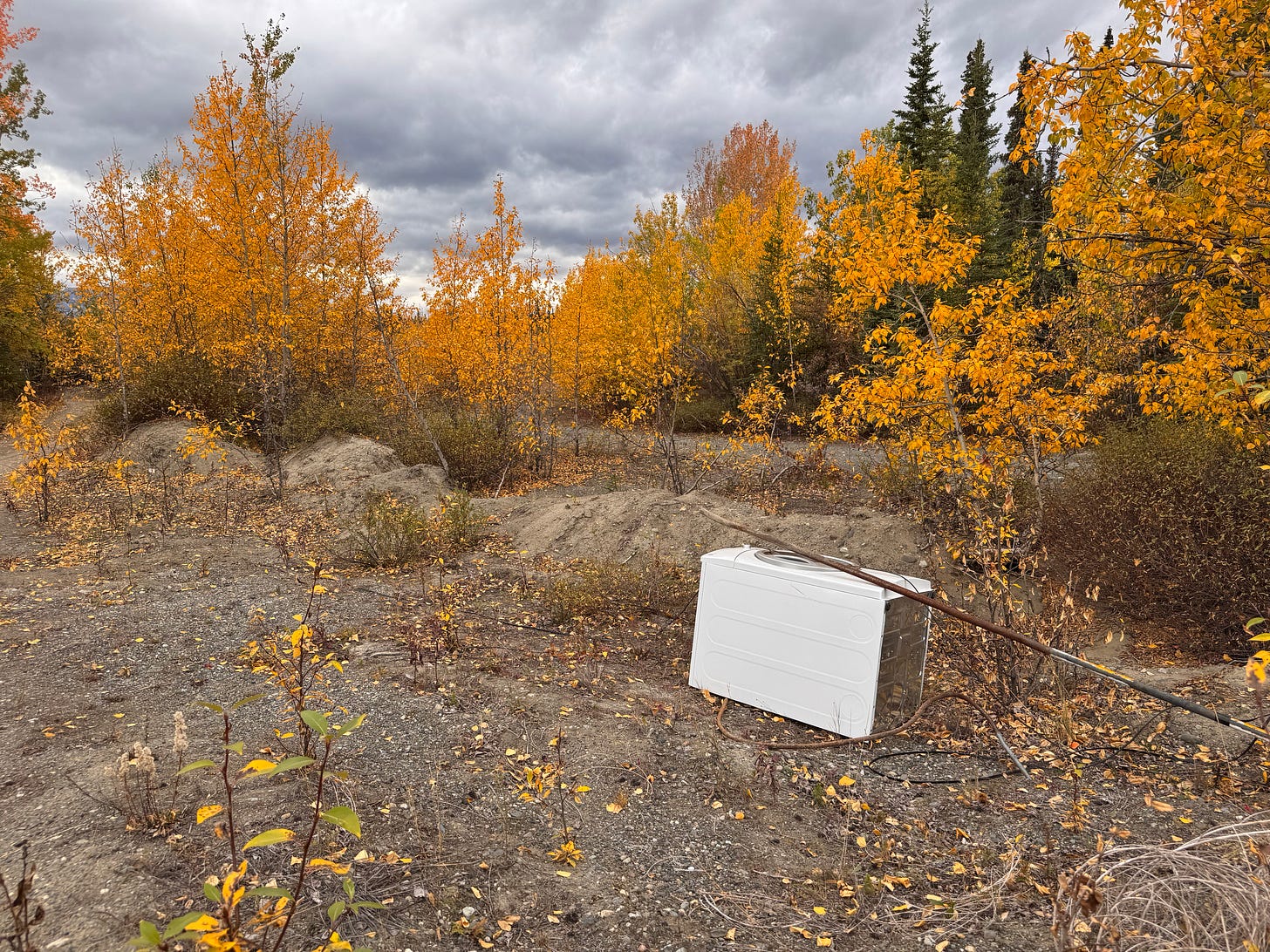Front-Loading Grayling
A meander on Marshall Creek, Yukon Territory.
In rural communities all over the world, the story of some homes can be read from the large and small detritus found surrounding the structure. The uninformed will declare this slovenly behavior to be that of an incorrigible slob or hoarder. Perhaps the person has a mental illness.
My experience, as a citizen of a rural community, is that the explanation has little to do with personal habits. It’s often simple economics, logistics, or both. It costs money to dispose of large articles at the dump. You have to be able to get them there. The yard is free. If you’re concerned about your home’s aesthetics, you use someone else’s yard. Or, more often, the roadside.
Twenty-minutes east of Haines Junction, just off the Alcan is an angler’s navigational aid. A front-loading dishwasher sits near the fork in a gravel road. The instructions I received went something like this.
Park at the top of the road and walk down to the water. At the top-loading dishwasher, take a left. Yes, it’ll be the one with the old TV antenna leaning on it. Go around the ancient pick-up truck and to the left of the gravel pit. Enter the water by the steel chair frame.
These directions were to a creek that started on the Kluane Plateau, slid past Paint Mountain, and began a meandering journey to the sea. We were told that grayling could be found in these headwaters so we rigged light rods and ties on dries. This would be a nice respite from casting heavy streamers on 8 weights.
Tony went downstream to some likely water and I went up to explore around the bend. There were no good runs upstream, just lots of wood. While I’m not shy of fishing among log jams, the combination of overhanging branches and leader snagging wood were a potent portent of frustration. I made a few half-hearted casts and went downstream to see what kind of water Tony was into.
On my way back I passed the chair frame. The swift current flowed along the far bank and most of the wood ran parallel to the bank. This wood looked less dangerous than the upstream tangles so I added a dropper and made a few drifts. I was shortly rewarded by my first grayling of the day, a fat sixteen inch fish.
Grayling are a curious fish. The first thing that strikes you when you bring one to hand is how firm they are. Rock solid. I’ve tried to think of the appropriate metaphor and am stumped. Solid and fiery. They do not give up easily and will struggle incessantly as you try to unhook them. Finally their coloration also defies description. Silver in most light, holographic at just the right angle. And that fin.
My initial impression of the Grayling was that they were the brook trout of the northwest. They’re found in many streams. They are prolific. They’re the poster child for cold clear water. However, Grayling differ from brookies in important ways.
First, they’re virtually unspookable. Sure they’re wary of the angler but instead of vanishing into some hidey-hole, they just ease out of the way. You can sight fish to grayling that are no more than a rod’s length always.
Second, where you find one grayling, you’ll find a hundred grayling. Their schooling behavior probably helps explain why they don’t disappear when a predator appears. They’re betting that the angler will flock-shoot the school and miss them all.
They are similar to brookies in that they’ll go after anything that looks like food. We caught them on dries, droppers, streamers, and even dries stripped through the water.
I joined Tony at several long runs he had discovered below the gravel pit. Again, plenty of wood. Also, plenty of fish. We caught them from six inches to pushing eighteen or so. We eventually switched to large hooks to reduce the likelihood of catching the over-eager yearlings.
We fished until it felt gratuitous and then fished a little while longer. The sun moved on and the wind picked up. It was about an hour back to the lodge and we needed to return before dinner lest they send out a search team.
The hand of man can be seen everywhere on this planet, from large communities to remote mountain roads. We leave our mark and our trash wherever we go. In a place where 48,000 people inhabit a land twice the size of New England we still use a rusty washing machine as a landmark. It says something about us, though I’m not exactly sure what.


